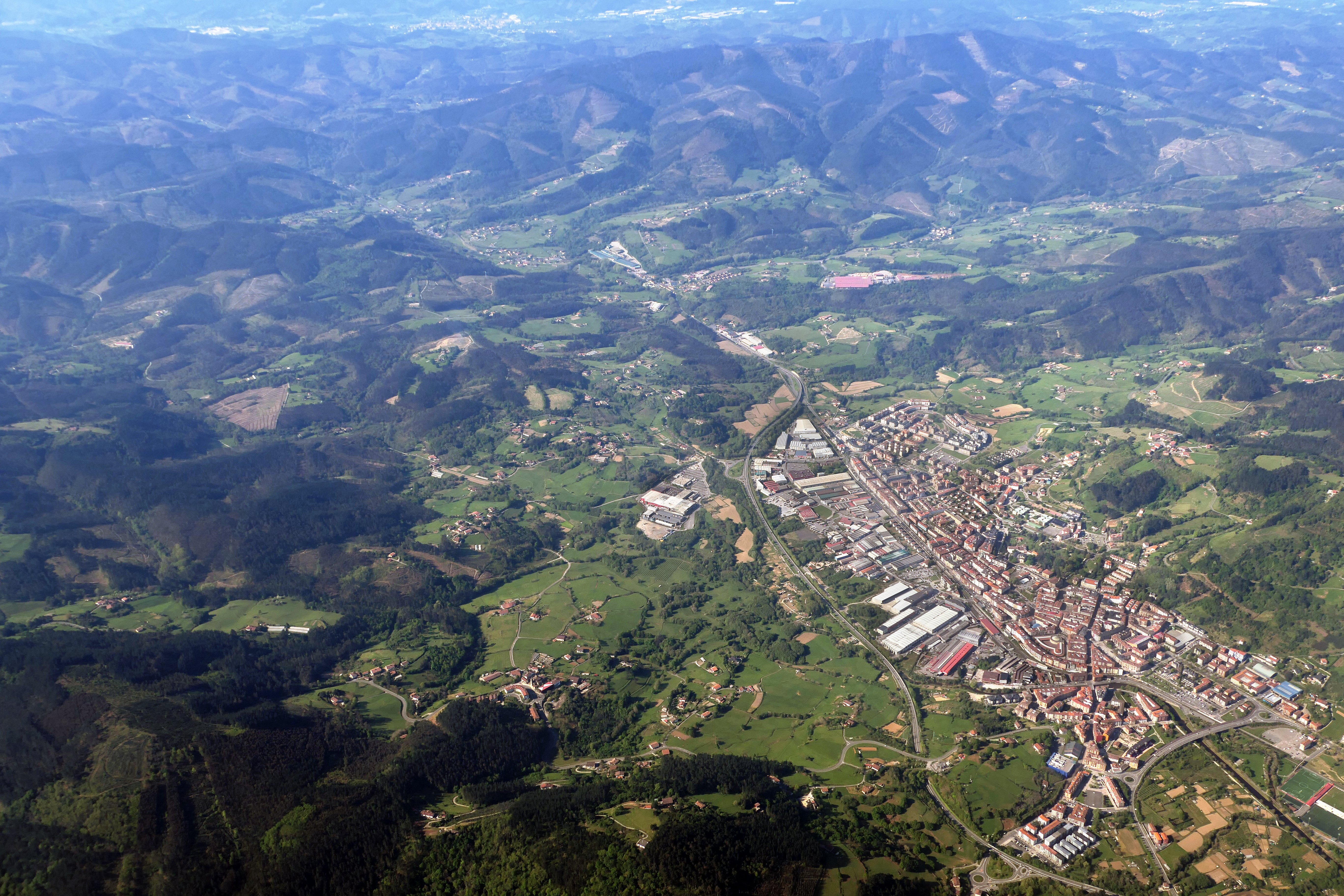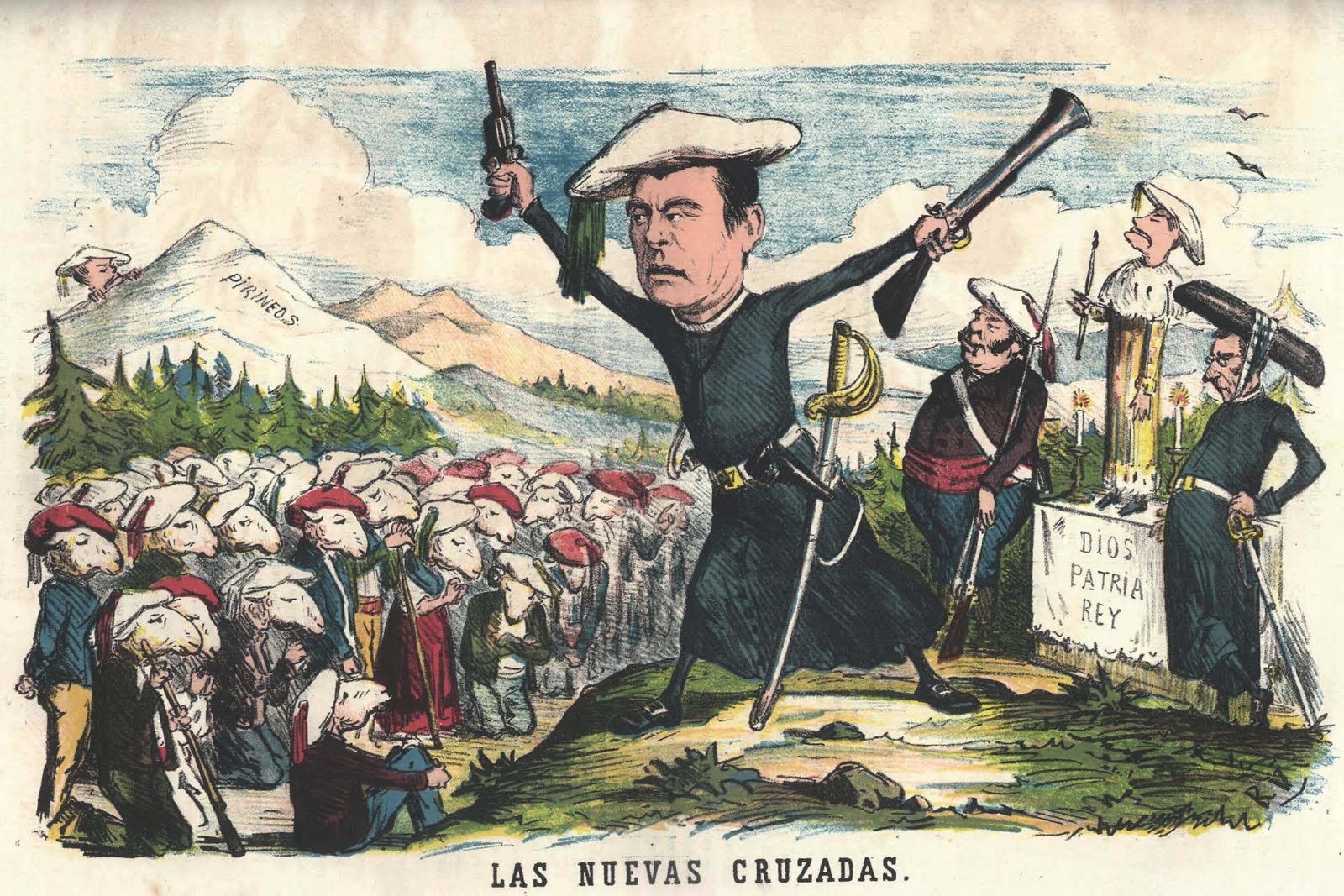|
Teodoro De Arana Y Beláustegui
Teodoro Benigno Ignacio de Arana y Beláustegui (1858–1945) was a Spanish Carlism, Carlist politician. His career climaxed during last decades of the Restoration (Spain), Restoration period: in 1903 he was elected to Congress of Deputies, Congreso de los Diputados, the lower chamber of the Cortes, and in 1905, 1916 and 1918 he was voted into the Senate of Spain, Senate. In two separate spells of 1915–1919 and 1923–1932, Arana served as leader of the Biscay branch of Carlism. He was also known as a vehement advocate of separate legal establishments for the Spanish names of the Basque Country, Basque provinces, as the author of a related pamphlet and as a promoter of Basque culture. He was the first person in Spain to send a telegram in Basque language, Basque. Family and youth The surname of Arana has been recorded already in the Middle Ages, Medieval period, but ancestors of Teodoro can be traced back only to the early 18th century; his great-great-grandfather, born in 1703 ... [...More Info...] [...Related Items...] OR: [Wikipedia] [Google] [Baidu] |
Guernica
Guernica (, ), officially Gernika () in Basque, is a town in the province of Biscay, in the Autonomous Community of the Basque Country, Spain. The town of Guernica is one part (along with neighbouring Lumo) of the municipality of Gernika-Lumo (), whose population is 16,224 . On April 26, 1937, Guernica was bombed by Nazi Germany's Condor Legion and Fascist Italy's Aviazione Legionaria, in one of the first aerial bombings. The attack inspired Pablo Picasso's painting '' Guernica'', depicting his outrage at the attack. Location The village is situated in the region of Busturialdea, in the valley of the Oka river. The river ends in an estuary that gives its name to the village of Guernika. Its mouth is known as the Urdaibai's estuary's heart. Gernika borders on the following townships: * North: Forua, Kortezubi and Arratzu * East: Ajangiz * South: Muxika * West: Errigoiti History 1366-1936 The town of Guernica was founded by Tello Alfonso, Lord of Biscay, on Apri ... [...More Info...] [...Related Items...] OR: [Wikipedia] [Google] [Baidu] |
Bachillerato
The Spanish Baccalaureate (, ) is the post-16 stage of education in Spain, comparable to the A Levels in England, Wales and Northern Ireland, Highers in Scotland, the French Baccalaureate in France or the International Baccalaureate. It follows the ESO (compulsory stage of secondary education). After taking the ''Bachillerato'', a student may enter vocational training (Higher-level Training Cycles, ''Ciclos Formativos de Grado Superior'') or take the " ''PAU''" (also commonly known as " ''PEvAU''" or "''Selectividad''") exams in order to be admitted into a public university. There are two parts, a core curriculum with the compulsory subjects (" fase de acceso") and a specialist part (" fase de admisión") with a number of pre-selected branches to choose from. The latter of these is technically optional, however reaching the necessary grade is significantly harder or impossible to achieve. History In Spanish (and Hispano-American) education from the 13th century up to the 17th or ... [...More Info...] [...Related Items...] OR: [Wikipedia] [Google] [Baidu] |
Third Carlist War
The Third Carlist War (), which occurred from 1872 to 1876, was the last Carlist War in Spain. It is sometimes referred to as the "Second Carlist War", as the earlier Second Carlist War, "Second" War (1847–1849) was smaller in scale and relatively trivial in political consequence. Leading up to the war, Queen Isabella II of Spain, Isabella II abdicated the throne in 1868, and the unpopular Amadeo I of Spain, Amadeo I, son of King Victor Emmanuel II of Italy, was proclaimed King of Spain in 1870. In response, the Carlist pretender, Carlos, Duke of Madrid, Carlos VII, tried to earn the support of various Spanish regions by promising to reintroduce various area-specific customs and laws. The Carlists proclaimed the restoration of Catalonia, Catalan, Kingdom of Valencia, Valencian and Aragonese fueros (charters) which had been abolished at the beginning of the 18th century by King Philip V of Spain, Philip V in his unilateral Nueva Planta decrees. The call for rebellion made by the ... [...More Info...] [...Related Items...] OR: [Wikipedia] [Google] [Baidu] |
Traditionalism (Spain)
Traditionalism () is a Spanish political doctrine formulated in the early 19th century and developed until today. It understands politics as implementing Catholic social teaching and the social kingship of Jesus Christ, with Catholicism as the state religion and Catholic religious criteria regulating public morality and every legal aspect of Spain. In practical terms it advocates a loosely organized monarchy combined with strong royal powers, with some checks and balances provided by organicist representation, and with society structured on a Corporatist, corporative basis. Traditionalism is an ultra-reactionary doctrine; it rejects concepts such as democracy, human rights, constitution, universal suffrage, sovereignty of the people, division of powers, religious liberty, freedom of speech, equality of individuals, and parliamentarism. The doctrine was adopted as the theoretical platform of the Carlism, Carlist socio-political movement, though it appeared also in a non-Carlist inc ... [...More Info...] [...Related Items...] OR: [Wikipedia] [Google] [Baidu] |
Vista De La Localidad De Azpeitia (1 De 1) - Fondo Marín-Kutxa Fototeka
Vista may refer to: Software *Windows Vista, the line of Microsoft Windows client operating systems released in 2006 and 2007 *VistA, (Veterans Health Information Systems and Technology Architecture) a medical records system of the United States Department of Veterans Affairs and others worldwide * VISTA (comparative genomics), software tools for genome analysis and genomic sequence comparisons * VistaPro, and Vista, 3D landscape generation software for the Amiga and PC *VIsualizing STructures And Sequences, bioinformatics software Organizations and institutions *Vista Group, a New Zealand software company specializing in solutions for the cinema industry *AmeriCorps VISTA, a national service program to fight poverty through local government agencies and non-profit organizations *Ventura Intercity Service Transit Authority, a public transportation agency in Ventura County, California, US *Vista Community College, now Berkeley City College, a community college in Berkeley, Californ ... [...More Info...] [...Related Items...] OR: [Wikipedia] [Google] [Baidu] |
Argentina
Argentina, officially the Argentine Republic, is a country in the southern half of South America. It covers an area of , making it the List of South American countries by area, second-largest country in South America after Brazil, the fourth-largest country in the Americas, and the List of countries and dependencies by area, eighth-largest country in the world. Argentina shares the bulk of the Southern Cone with Chile to the west, and is also bordered by Bolivia and Paraguay to the north, Brazil to the northeast, Uruguay and the South Atlantic Ocean to the east, and the Drake Passage to the south. Argentina is a Federation, federal state subdivided into twenty-three Provinces of Argentina, provinces, and one autonomous city, which is the federal capital and List of cities in Argentina by population, largest city of the nation, Buenos Aires. The provinces and the capital have their own constitutions, but exist under a Federalism, federal system. Argentina claims sovereignty ov ... [...More Info...] [...Related Items...] OR: [Wikipedia] [Google] [Baidu] |
Cortes Generales
The (; ) are the Bicameralism, bicameral legislative chambers of Spain, consisting of the Congress of Deputies (the lower house) and the Senate of Spain, Senate (the upper house). The Congress of Deputies meets in the Palacio de las Cortes, Madrid, Palacio de las Cortes. The Senate meets in the Palacio del Senado. Both are in Madrid. The Cortes are elected through universal, free, equal, direct and secret suffrage, with the exception of some senatorial seats, which are elected indirectly by the legislatures of the Autonomous communities of Spain, autonomous communities. The are composed of 615 members: 350 Deputies and 265 Senators. The members of the serve four-year terms, and they are representatives of the Spanish people. In both chambers, the seats are divided by constituencies that correspond with the Provinces of Spain, fifty provinces of Spain, plus Ceuta and Melilla. However, each island or group of islands within the Canary Islands, Canary and Balearic Islands, Bal ... [...More Info...] [...Related Items...] OR: [Wikipedia] [Google] [Baidu] |
Philippines
The Philippines, officially the Republic of the Philippines, is an Archipelagic state, archipelagic country in Southeast Asia. Located in the western Pacific Ocean, it consists of List of islands of the Philippines, 7,641 islands, with a total area of roughly 300,000 square kilometers, which are broadly categorized in Island groups of the Philippines, three main geographical divisions from north to south: Luzon, Visayas, and Mindanao. With a population of over 110 million, it is the world's List of countries and dependencies by population, twelfth-most-populous country. The Philippines is bounded by the South China Sea to the west, the Philippine Sea to the east, and the Celebes Sea to the south. It shares maritime borders with Taiwan to the north, Japan to the northeast, Palau to the east and southeast, Indonesia to the south, Malaysia to the southwest, Vietnam to the west, and China to the northwest. It has Ethnic groups in the Philippines, diverse ethnicities and Culture o ... [...More Info...] [...Related Items...] OR: [Wikipedia] [Google] [Baidu] |
Liverpool
Liverpool is a port City status in the United Kingdom, city and metropolitan borough in Merseyside, England. It is situated on the eastern side of the River Mersey, Mersey Estuary, near the Irish Sea, north-west of London. With a population of (in ), Liverpool is the administrative, cultural and economic centre of the Liverpool City Region, a combined authority, combined authority area with a population of over 1.5 million. Established as a borough in Lancashire in 1207, Liverpool became significant in the late 17th century when the Port of Liverpool was heavily involved in the Atlantic slave trade. The port also imported cotton for the Textile manufacture during the British Industrial Revolution, Lancashire textile mills, and became a major departure point for English and Irish emigrants to North America. Liverpool rose to global economic importance at the forefront of the Industrial Revolution in the 19th century and was home to the Liverpool and Manchester Railway, firs ... [...More Info...] [...Related Items...] OR: [Wikipedia] [Google] [Baidu] |
Mundaka
Mundaka () is a town and municipality located in the province of Biscay, in the autonomous community of Basque Country, in northern Spain. Mundaka is internationally renowned for the surfing community that takes advantage of its coast and unique oceanic conditions. Mundaka is accessible from Bilbao by EuskoTren on the E4 Urdaibai line. History Mundaka is known as one of the most historically important places of the Lordship of Biscay, it is the believed birthplace of Jaun Zuria, the first Lord of Biscay, son of the Scottish princess who arrived in Mundaka escaping from an English King. The name of the town has Danish origin, and it is speculated that the town had Viking influence during the late first millennium, AD. According to the history of the Lordship, Mundaka has the oldest temple in Biscay. As a result, it has the first seat of the General Parliament. The port is the centerpoint of the town, where the town initially expanded from. Most of the houses in Mundaka are ... [...More Info...] [...Related Items...] OR: [Wikipedia] [Google] [Baidu] |
Guernica 1922
Guernica (, ), officially Gernika () in Basque, is a town in the province of Biscay, in the Autonomous Community of the Basque Country, Spain. The town of Guernica is one part (along with neighbouring Lumo) of the municipality of Gernika-Lumo (), whose population is 16,224 . On April 26, 1937, Guernica was bombed by Nazi Germany's Condor Legion and Fascist Italy's Aviazione Legionaria, in one of the first aerial bombings. The attack inspired Pablo Picasso's painting ''Guernica'', depicting his outrage at the attack. Location The village is situated in the region of Busturialdea, in the valley of the Oka river. The river ends in an estuary that gives its name to the village of Guernika. Its mouth is known as the Urdaibai's estuary's heart. Gernika borders on the following townships: * North: Forua, Kortezubi and Arratzu * East: Ajangiz * South: Muxika * West: Errigoiti History 1366-1936 The town of Guernica was founded by Tello Alfonso, Lord of Biscay, on April 28, 1366, ... [...More Info...] [...Related Items...] OR: [Wikipedia] [Google] [Baidu] |
Guadix
Guadix (, ) is a city and municipalities of Spain, municipality in southern Spain, in the Granada (province), province of Granada. The city lies at an altitude of 913 metres, in the centre of the Hoya of Guadix, a high plain at the northern foothills of the Sierra Nevada (Spain), Sierra Nevada. It is located on the Linares Baeza–Almería railway. The city was built in the vicinity of gullies and badlands. History Early history Evidence of human settlement in the area surrounding Guadix goes back to at least the Bronze Age. Ancient Guadix el Viejo, 6 km northwest, was the Roman Acci (also ''Accitum'') mentioned in Pliny's Natural History and as Akki by Ptolemy, who placed it among the Bastetani, whose capital was Baza, Granada, Basti. It is not known for certain whether it is of Phoenician or of early Spanish origin. The existence of an ''oppidum'' with a well-defined urban plan from the 6th century BC has been documented; archeological excavations have revealed complex ... [...More Info...] [...Related Items...] OR: [Wikipedia] [Google] [Baidu] |





